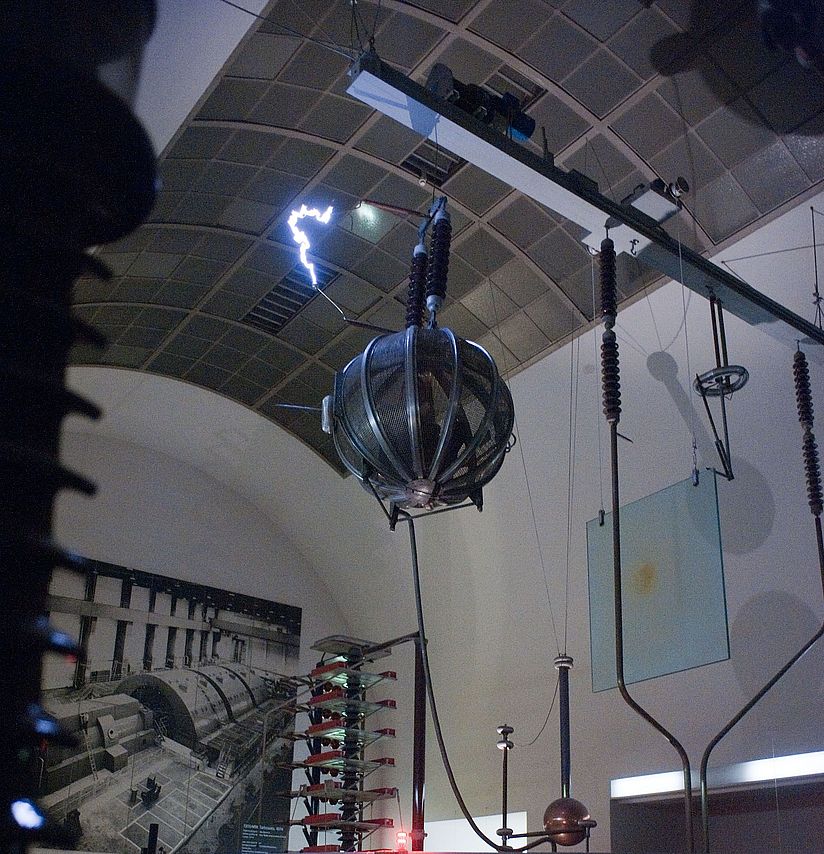
Photo: Deutsches Museum
Electric Power
High-voltage installation
The show classic with one million volts. In the demonstration of the high-voltage installation, lightning strikes on a regular basis and the Faraday cage is subject to a high-voltage current.
Experience high voltage live

The Faraday cage is subject to a high-voltage current. Photo: Deutsches Museum
The demonstration of the high-voltage installation is one of the classic features of the Deutsches Museum. The demonstration allows you to experience high-voltage phenomena up close.
The effective experiments with an alternating voltage of up to 300,000 volts are followed by experiments with pulse voltages, which achieve a peak value of almost one million volts in two millionths of a second and thus simulate lightning strikes with a discharge current of up to 1,000 amps.
The demonstration of the Faraday cage is particularly exciting. An employee of the Deutsches Museum is exposed to a lightning strike live in the Faraday cage.
The effective experiments with an alternating voltage of up to 300,000 volts are followed by experiments with pulse voltages, which achieve a peak value of almost one million volts in two millionths of a second and thus simulate lightning strikes with a discharge current of up to 1,000 amps. An employee of the Deutsches Museum climbs into the Faraday cage and is exposed to a lightning strike.
The high-voltage installation after Hans Prinz in the Electric Power exhibition. Photo: Deutsches Museum
The high-voltage installation after Hans Prinz
Electrical energy is often referred to simply as “electricity”. The physical process is the conversion from mechanical energy on the basis of the induction phenomena found by Michael Faraday in 1831: with the same power, the higher the voltage, the lower the current, and the lower the current, the lower the transmission losses. Due to the familiarity with direct current that had developed historically in the use of accumulators, direct current systems with central stations in the middle of the supply area were set up to begin with, which were only in operation in the morning and evening, as electric motors were only introduced gradually. Soon, however, the electric drives required more energy than the electric lighting. Therefore, the idea was conceived of conducting electricity from power stations in a convenient location out of town into the consumer centres with an increase in the transmission voltages: since the invention of the transformer in 1885, the generator outputs grew from a few kilowatts (kVA) to over 1,000 megawatts (MVA) and the transmission voltages from a few hundred volts to several hundred kilovolts.
This demonstration, which is unique in the world, was set up under the leadership of Hans Prinz (1907-1978), Professor of High Voltage Engineering and Switchgear Technology at TH Munich. During the demonstration, the visitor discovers high-voltage engineering through alternating current and through impulse voltages. The former is the type of voltage used in our energy supply, the latter are produced by storms and switching operations and can cause far-reaching disruptions.
This complex installation that is remarkable from an engineering perspective has been in operation since 1953. When selecting the demonstrations, great care was taken to set up the programme sequence such that the essence of the relevant effect can be demonstrated in a way that even laypeople can understand within a manageable timeframe and with the help of a just a few experiments.
1835the physicist Faraday carried out a first experiment with the Faraday cage.

The Faraday cage under high voltage. Photo: Deutsches Museum
The Faraday Cage
With an alternating voltage of 50 hertz (which corresponds to the frequency of the domestic power supply), the shielding effect of a Faraday cage against electric fields is established particularly impressively by bringing a wire mesh ball that is insulated from the Earth to a high voltage potential after a person has taken up a position inside it. The Faraday ball, which has no fields inside it, has a diameter of 120cm. It is insulated from the crossbar by two rod insulators arranged next to one another and can be lowered by the control panel so that it is low enough for a person to sit inside it. Then the ball is pulled up and the test transformer is stimulated to such an extent that, at around 270kV, there is a breakdown at the 70cm spark gap parallel to the rod insulators and the layperson can see that the ball really has been subject to a high voltage.
In the second part of the alternating voltage experiments, the effect of high-current alternating current electric arcs and the electro-dynamic force effect of high-current copper cables are demonstrated to the visitor.
Demonstration programme
With alternating voltages of 50Hz, we demonstrate:
- 300,000 volt transformer:
the discharge operation (corona) and voltage breakdown in the air,
the voltage flashover (sliding discharges) between glass and air,
the protective effect of a Faraday cage,
the voltage measurements with a ball spark gap,
the course of the electric field lines according to the Strohhalm method - migrating electric arcs
- the force effect of electric currents
With a surge generator with voltage impulses of up to 1 million volts and 50 millionths of a second in duration, we demonstrate:
- simulated lightning effects:
in I:25 models of a church, a house and an overhead line,
and in trees (wooden stick) - the loud evaporation of a fine wire
Impressions
The high-voltage installation in the Deutsches Museum
One of the most popular destinations in the Deutsches Museum is the high-voltage installation. In the daily demonstrations, visitors can experience high-voltage phenomena up close. The effective experiments with alternating voltage of up to 300,000 volts and a current of up to 1,000 amps are followed by experiments with pulse voltages, which achieve a maximum voltage of almost one million volts in two millionths of a second and thus simulate lightning strikes. The demonstration of the Faraday cage is very impressive: a wire mesh ball is raised to a height of three metres with an employee of the Deutsches Museum sitting in it. Now a voltage of around 270,000 is applied, which can be seen in the form of a breakdown at a spark gap. However, the employee leaves the Faraday cage unharmed. The reason for this is that the interior space is shielded from external electric fields and electromagnetic waves by a continuous sleeve of conductive material. The film is currently only available in German.

